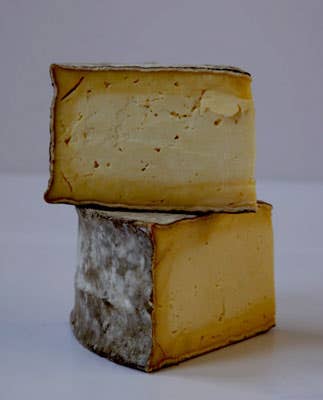
Welsh Wonder
If the original makers of caerphilly could see their cheese now—sitting in glass cases at gourmet markets across Britain and the United States—they wouldn't believe their eyes. Theirs, unlike long-aged cheddar or assertive stilton, had never been a fancy cheese. Caerphilly was a simple, brined wheel of cows' milk that Welsh dairy farmers had been making since the early 1800s. It was a fresh, milky cheese, the kind workers would have for lunch with a pint of beer. And now, after an absence of nearly a hundred years, real handmade caerphilly has returned to Wales—and, you might say, in a rather grander style than when it left.
The production of old-style caerphilly largely ceased in Wales in 1914, when Welsh cheese makers were forced to stop their work because of wartime restrictions. Those were dark days for British cheese, when farmhouse methods were mostly abandoned in the name of progress. You could buy a fresh cheese called caerphilly in England after the world wars, but it came from English factory creameries, not Welsh farms; in fact, industrial creameries loved caerphilly because they didn't have to age the cheese and could turn a profit on it quickly. By the 1950s, it had become a supermarket staple in England and nothing like the more nuanced cheese that Welsh farmers used to make.
All the while, though, a few stubborn cheese makers in Somerset, England, which borders Wales, had been carrying on the business of crafting caerphilly the traditional way, cutting the curds by hand and, in some cases, letting the wheels age until they developed a flavorful rind and a complex-tasting, creamy interior. In 1979, Randolph Hodgson, the founder of the venerable London cheese shop Neal's Yard Dairy, tasted some of that aged caerphilly, produced by a third-generation Somerset cheese maker named Chris Duckett. He fell in love, and soon so did his customers. In England, aged caerphilly began to take its place in the pantheon of British cheeses alongside cheddar and stilton.
But you still couldn't get it from Wales. Then, in the mid-1990s, a former Neal's Yard employee named Todd Trethowan decided it was time to bring real caerphilly home. Trethowan worked with Chris Duckett to learn the old method, and in 1996 he started making caerphilly at his parents' Gorwydd farm in the Welsh town of Llanddewi Brefi. He aged it for an average of two to three months; the result had a marvelously creamy texture and an earthy taste. Today Gorwydd caerphilly is coveted by connoisseurs all over Britain and, more important, well loved in its native land.
Keep Reading
Continue to Next Story










